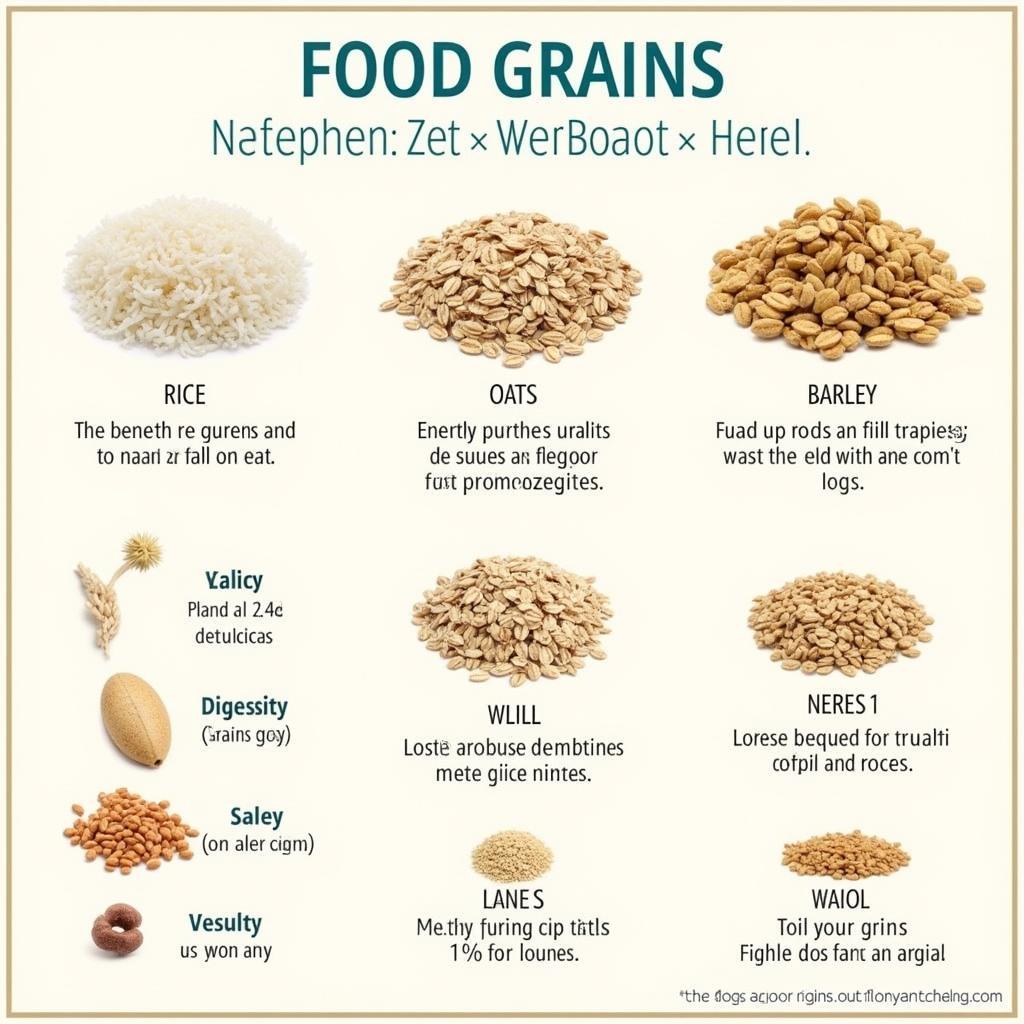Adding grains to a grain-free dog food can be a tricky process, but it’s often necessary for picky eaters or dogs with specific dietary needs. This comprehensive guide will walk you through the hows and whys of introducing grains back into your dog’s diet. We’ll cover everything from understanding your dog’s individual needs to choosing the right grains and monitoring for any adverse reactions.
Why Consider Adding Grains?
Some dogs simply thrive on a diet that includes grains. They can provide a valuable source of energy, fiber, and essential nutrients. For dogs accustomed to grain-inclusive food, switching to a completely grain-free diet can sometimes lead to digestive upset or decreased appetite. In such cases, adding grains back in can be beneficial. This is especially true for dogs who need extra fiber for digestive health. YumWoof offers a variety of grain-inclusive options, you can check out our yumwoof dog food reviews.
Benefits of Grains for Some Dogs
- Improved digestion: Certain grains like rice and oats can be easily digestible and help regulate bowel movements.
- Increased energy levels: Grains offer a readily available source of carbohydrates, which are crucial for energy production.
- Enhanced coat and skin health: The nutrients in grains contribute to a healthy, shiny coat and reduce skin issues.
- Cost-effectiveness: Grain-inclusive diets are often more affordable than grain-free options.
Choosing the Right Grain
Not all grains are created equal. Some are more digestible than others, and some dogs might have sensitivities to specific grains. It’s important to choose grains that are less likely to cause allergic reactions and offer optimal nutritional value.
 Selecting suitable grains for dogs
Selecting suitable grains for dogs
Recommended Grains for Dogs
- Rice (brown or white): Easily digestible and a good source of carbohydrates. Brown rice offers more fiber than white rice.
- Oats (rolled or cooked): Rich in fiber and can help with digestive issues. Make sure they are cooked, as raw oats can be difficult for dogs to digest.
- Barley: A good source of fiber and beta-glucans, which can support immune function.
- Quinoa: Technically a seed, but often used like a grain. A complete protein source and rich in nutrients.
How to Add Grain to a Grain-Free Dog Food
The key is to introduce grains gradually. Start with a small amount and slowly increase the portion over several days or weeks, monitoring your dog for any digestive upset or allergic reactions.
Step-by-Step Guide
- Choose your grain: Select a dog-friendly grain like rice, oats, or barley.
- Prepare the grain: Cook the grain according to package directions. Make sure it is cooked thoroughly and cooled down before adding it to your dog’s food.
- Start small: Begin by adding a very small amount of cooked grain (e.g., a teaspoon) to your dog’s regular grain-free food.
- Observe your dog: Monitor your dog for any signs of digestive upset, such as vomiting, diarrhea, or gas.
- Gradually increase: If your dog tolerates the grain well, gradually increase the amount you add over the next few days or weeks. Triumph Wild Spirit provides a balanced diet; explore our review on triumph wild spirit dog food.
- Monitor consistency: Pay attention to your dog’s stool. It should be firm and well-formed. If it becomes too loose or too hard, adjust the amount of grain accordingly.
- Consult your vet: If you notice any adverse reactions, discontinue adding grains and consult your veterinarian.
“Adding grains back into a grain-free diet should be a slow and monitored process,” says Dr. Emily Carter, DVM. “It’s crucial to observe your dog’s individual response and adjust the amount accordingly.”
When to Avoid Adding Grains
While grains can be beneficial for some dogs, they are not suitable for all. If your dog has a known grain allergy or intolerance, avoid adding grains to their diet. Some grain-free dog foods are specially formulated for breeds with sensitivities, like French Bulldogs. Discover some recommendations in our recommended food for french bulldogs.
“Not all dogs benefit from grains,” adds Dr. Carter. “If your dog is thriving on a grain-free diet, there’s no need to add grains unless recommended by your vet.” Some breeds thrive on high-energy diets, which may or may not include grains, as highlighted in our diamond hi energy dog food review. A more natural option you might want to explore is sprout naturals dog food.
Conclusion
Adding grain to a grain-free dog food can be a healthy choice for some dogs, but it’s important to do it carefully and monitor your dog’s individual response. By following the steps outlined in this guide and choosing the right grains, you can help ensure your dog receives a balanced and nutritious diet.
FAQ
- What are the signs of a grain allergy in dogs?
- Can I add grains to wet grain-free dog food?
- What are some alternative sources of fiber for dogs who can’t tolerate grains?
- How much grain should I add to my dog’s food per day?
- Are all grains equally nutritious for dogs?
- Can puppies eat grains?
- What should I do if my dog experiences digestive issues after eating grains?
Contact us for support: Phone: 02437655121, Email: minacones@gmail.com or visit us at 3PGH+8R9, ĐT70A, thôn Trung, Bắc Từ Liêm, Hà Nội, Việt Nam. We have a 24/7 customer service team.